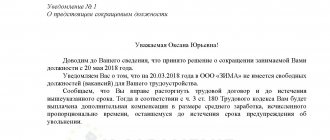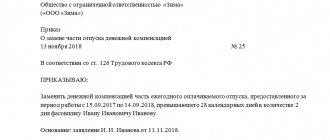On July 13, 2021, the President of Russia signed Federal Law No. 210-FZ “On amendments to the Labor Code of the Russian Federation regarding the provision of guarantees to an employee dismissed due to the liquidation of an organization,” which introduced changes and additions to Articles 178, 318, 327.7 , 349.3 of the Labor Code of the Russian Federation (hereinafter referred to as the Labor Code of the Russian Federation).
The new version of Articles 178, 318 of the Labor Code of the Russian Federation, regulating payments by employers of severance pay to laid-off employees, came into force on August 13, 2021. What's new in these articles?
What is dismissal due to reduction?
This is one of the ways to optimize work in an enterprise. Labor legislation fully regulates issues related to this topic. It sets out the procedure for the actions of the company’s management, and which it is obliged to fully comply with.
For example, it is obliged to notify the employee of dismissal at least two months before in writing and against signature.
Taxation and contributions
However, the above calculation is only the first step. We must not forget about taxation and contributions. According to Art. 217 of the Tax Code of the Russian Federation, personal income tax is paid on compensation for vacation in case of staff reduction. Therefore, the dismissed employee will receive a smaller amount.
When calculating personal income tax, you need to keep the following factors in mind:
- Tax rate. For residents, that is, citizens permanently residing in Russia, it is 13%.
- Amount of accrued compensation.
Compensation is not subject to personal income tax only in one case - if the employee died before receiving it, and it is inherited by his relatives (clause 18 of article 217 of the Tax Code of the Russian Federation).
In addition to personal income tax, contributions to the Pension Fund, Social Insurance Fund, and the Federal Compensation Fund are withheld from compensation. The basis for this is clause 2, clause 1 of Art. 422 of the Tax Code of the Russian Federation. These contributions are transferred to the budget in the usual manner, that is, on the 15th day of the month following the dismissal.
What is required for a contracting person?
Only strict compliance with the requirements of the Labor Code of the Russian Federation will allow management to legally terminate employment relations with part of the team and pay them the payments required by law.
The main and mandatory ones are the following: severance pay, compensation for unused vacation days, and salary. According to the law, the total amount should be enough for the dismissed person during the period of searching for a new job.
Let's look at each type of payment in more detail.
Severance pay
It is assigned to the dismissed person due to reduction in the form of compensation for subsequent income spent. The benefit amount is equal to the employee’s average monthly earnings at the enterprise. It lasts for as long as you are busy writing a new job, but no more than two months from the date of layoff.
Roughly speaking, severance pay is two salaries.
But if you found a job earlier than the two months specified in the law have passed, then the benefit is calculated for the days that you spent without work.
Therefore, many use a little trick - they do not get a job until these two months have expired. Or they agree with the new employer that they will work the first two months at the new place unofficially.
Vacation pay compensation
This is the second of the guaranteed payments. In this case, the dismissed employee will be compensated for all days of unused vacation in cash equivalent. True, this payment is assigned for any reason when an employee leaves the enterprise.
The dismissed person needs to know that the specified amount is subject to income tax.
Salary for the period of work before dismissal
In this case, the employer pays the dismissed employee wages for all actually worked days of the month. This payment upon dismissal during layoff is the main type of compensation in this case.
Ask why the main type of compensation. The thing is that its amount affects the amount of other additional payments. This payment is guaranteed by the Labor Code of the Russian Federation. Payment occurs on the day of dismissal in full.
Downsizing – what is it?
Reducing the number or staff of employees is a method provided by law for terminating labor relations at the initiative of the employer (clause 2 of Article 81 of the Labor Code of the Russian Federation). The reasons for such a reduction are not indicated, which means they can be anything, but the procedure itself is clearly regulated and its violation can lead to serious sanctions for the owners of the enterprise.
It is obvious that in the very wording, and in labor legislation, this very terminology is used - Reduction in the number or staff of employees, there is a difference between the terms “number” and “staff”. Is this an important parameter?
Reducing the number and staff - is there a difference?
There are no direct indications in the Labor Code of the difference between these terms. However, differences can be deduced from the letter and spirit of the law:
- A reduction in headcount is a reduction in the number of positions within the same type of staffing unit, despite the fact that the total number of such units remains greater than 0. For example, there were 10 cleaners working at the enterprise, and after the reduction in number there will be 5.
- Staff reduction is the complete elimination of staff for any position. For example, there were 10 cleaners, but after the reduction, there will be no cleaners at the enterprise at all.
In the context of the issue under consideration, the only difference in these concepts is the order (selection) of specific individuals for dismissal. When reducing staff, all units are fired without any advantages over each other, and the reduction in numbers implies a certain algorithm for selecting persons for dismissal. We will talk about this in more detail below.
Everything said below applies equally to any type of enterprise organization - individual entrepreneur, LLC, JSC, etc.
8(800)350-23-68
Dmitry Konstantinovich
Expert of the site "Legal Consultant"
Ask a Question
There is one more point that needs to be taken into account at the beginning of the proceedings. There is a process of dismissal due to liquidation of an enterprise that is largely similar, but still has fundamental differences. It requires a separate explanation, and will be touched upon superficially in this material.
Additional payments
If the terminated employment contract provides for other types of payments - bonuses, additional, so-called 13th salary, then this is also paid. True, for this you need to work at this enterprise for at least 12 months.
What to do if you haven’t found a job within two months, which is required by law. To receive payment for the third month, you will need to register with the employment service. And this must be done no later than 12 days from the date of dismissal. And if during this period the service could not find you a new job.
In this case, after the third month without work, the service will issue a notification about this. You must provide this paper to your previous place of work, and it is obliged to pay you the average salary.
Cash compensation for a vacation that was not used
The calculation and payment of compensation for unused vacation in the event of a reduction in staff or numbers is no different from the procedure that applies when dismissing an employee for other reasons. However, there are several non-obvious points that need to be kept in mind.
Calculation of the number of days
In order to pay the money, the employer needs to know how many days of paid rest the employee was entitled to at the time of dismissal. If he has worked for a full year, this is easy - just look at the employment contract.
However, this situation rarely happens: it usually turns out that more or less than a year has passed since the last vacation. How to be in this case?
It should be noted that this issue has not been fully settled by law. There are two methods for calculating compensation:
- Based on the Rules approved by the CNT of the USSR on April 30, 1930 No. 169 . According to these Rules, it is necessary to multiply the duration of leave under the employment contract by the number of months that have already been worked since the last leave or hire (if the employee has not yet been on leave) - and divide by 12.
- Based on the Recommendations of Rostrud (Minutes dated June 19, 2014 No. 2). It first calculates how many days of vacation the employee is entitled to for each month worked, and then the resulting number is multiplied by the number of months worked.
When using this method, intervals less than half a calendar month are not taken into account; more are rounded up to the whole value.For example, if an employee is entitled to 4 calendar weeks of vacation per year under a contract, then for each month he is entitled to 2.(3) (two and three in a period) days. Rostrud recommends rounding this figure to 2.33 days per billing month.
Since there are no instructions in the law yet, the employer has the right to use any of the above methods .
It should be taken into account that the proposal proposed by Rostrud suffers from some inaccuracy: for example, with 6 full months worked, which is exactly half of the year, an employee with 28 days of vacation has the right to count on 14 days - however, when calculating according to the Recommendations, the result is not 14, but 13.98.
It is in this regard that the Ministry of Health and Social Development of the Russian Federation, in letter No. 4334-17 dated December 7, 2005, directly calls on the employer to round such results in favor of employees - however, this letter is not binding.
IMPORTANT : It must be remembered that for some categories of workers the law provides for additional rest. In this regard, when calculating compensation, the employer must add additional days to the result of the above calculation.
In addition, if the employee has not taken a vacation for several years, compensation must be calculated for each year. Finally, if the employee partially used the vacation, then the days used are not taken into account in the calculation.
Calculation of payments
So, the number of days is known. Compensation upon dismissal is paid in the amount of the average daily wage multiplied by the number of days due. But how do you calculate the average salary for one day?
To calculate compensation, you must use the following indicators:
- The amount of income received by the employee at the place of performance of labor duties for the last calendar year. In the formula, this indicator will be designated as D.
- Average number of days per month. According to Decree of the Government of the Russian Federation No. 922 of December 24, 2007, this indicator should be 29.3 in calculations.
- The number of months in the billing period worked in full. Let us denote them in the formula as M1.
- The number of days in months when the employee did not work all days. Let's denote them as M2.
Now let’s look at each indicator separately.
What exactly is included in the amount of earnings?
To calculate the D indicator, it is necessary to take into account the standards set forth in the Decree of the Government of the Russian Federation No. 922 . According to clause 2 of this regulatory act, total income includes:
- Salary for each month of the pay period.
- Additional payments for experience, rank, skill, etc.
- Compensation for overtime work, work on holidays, special working conditions, etc.
- Prizes and bonuses provided for by the internal regulations of the enterprise and paid regularly.
In this case, the following payments received by the employee are not used for calculation :
- Social benefits and financial assistance (payment for vouchers, travel compensation, etc.).
- Dividends on company shares.
- Remuneration to persons participating in supervisory boards, boards of directors and other collective governing bodies of the organization.
What days worked are counted?
Days worked must be calculated in accordance with the production calendar in force at the enterprise . Usually, the calendar year is used as the calculation period, but by its order, the management of the enterprise can introduce other periods of time (quarter, half-year, month, etc.) to calculate the average daily earnings.
When calculating, all days when the employee performed his work duties are used. A full calculation of the number of days is carried out on the basis of time sheets, which must be kept for each employee. Their form was approved by Decree of the State Statistics Committee of the Russian Federation No. 1 of January 5, 2004. Although the use of this form is not mandatory since January 1, 2013, in practice they continue to be actively used.
If the employee worked a full annual pay period, then the average number of days in a month given above (29.3) can be used to calculate compensation . If it is less, then the days are counted.
Watch a video about compensation for leave upon dismissal:
Calculation of average daily earnings
Now we calculate the average daily earnings due to the employee. To do this, take the billing period valid at the enterprise and add up all the amounts included in indicator D.
Compensation is calculated using the following formula:
D / (M1 x 29.3 + M2)
Vacation compensation
Previously, we received the average daily earnings. In order to determine the amount of compensation due, it must be multiplied by the number of vacation days due to the employee (let’s denote it as O).
As a result, the final formula for calculating compensation (K) will look like this:
K = (D / (M1 x 29.3 + M2)) x O
This is the amount that should be charged to the employee.
Early layoff
The legislation provides for the possibility that the employer and employee can agree on early dismissal before the appointed reduction date. To put it simply, an employee, as soon as he receives notice of an upcoming layoff, comes to the employer and negotiates to be fired in advance before the scheduled date.
In this case, the legislation provides for additional payments to those listed above. This is compensation for the time that the employee could have worked before the dismissal date and received payment for it.
The calculation of additional compensation is as follows: the number of working days from the date of actual dismissal to the announced day of layoff must be multiplied by the average earnings per working day.
True, in this case, the dismissed employee does not retain compensation for the reduction, because in this case the dismissal occurs by mutual agreement of the parties.
Counting days worked
The easiest way to count days is to take a production calendar and subtract working days from the total number of days in a year.
Time not included in the calculation of the ERP
But it’s hard to find super-responsible employees; everyone is human: they get sick, take time off, sit on juries, and use other reasons not to come to work.
Labor legislation establishes a number of periods that are not taken into account when calculating compensation.
All these not included periods can be divided into 2 groups:
- The period of absence of an employee for which his average earnings were retained and already paid:
- illness on sick leave;
- maternity leave for childbirth and up to 3 years;
- a strike at an enterprise in which the employee did not participate;
- business trip;
- circumstances beyond the control of the parties (for example, natural disasters, etc.);
- training directed by the company;
- vacations, incl. additional;
- easy to use due to the fault of the company.
- Time of absence for other reasons during which SWP was not accrued - for example, on days off at the expense of the employee.
How to count work periods?
- Using the production calendar, we calculate the number of working days.
- We count the days that are not included.
- We subtract the second from the first - we get the actual time worked by the dismissed person.
We count accrued payments
After calculating the days worked, all payments made to the employee are calculated.
Article 139 of the Labor Code stipulates that only payments that are related to wages should be taken into account.
The entire list is contained in clause 2 of the Regulations on the calculation of FFP.
So, all salary income items are summed up:
- starting salaries and rates;
- various allowances for them;
- bonuses;
- additional payments for work in special (difficult) conditions or on holidays and weekends;
- any other “labor” income, both provided for by law and by the company itself.
When calculating, it does not matter what payment system the person worked under and how exactly he received his salary in hand - even income received in kind is taken into account.
What income is not taken into account for calculating the FFP?
Cash payments that were accrued to the employee in accordance with the right to maintain SWP during periods determined by law (more about them below).
- Payments that have nothing to do with the remuneration system - i.e.
social guarantee payments at the initiative of the employer. For example, voluntary health insurance, payment for a mobile phone, food subsidies, dividends, daily allowances for business trips, etc. This category also includes funds issued to an employee who took days off to care for a disabled relative. - The last case is compensation for downtime at work due to the fault of the company or in the event of disasters and other reasons that do not depend on the will of the parties.
We calculate the average earnings
For calculating the SWP, the period is considered to be the working year - 12 months from the date of admission.
The SWP formula is as follows: we divide the actual amount accrued for the work by 12 (months).
We receive a salary wage, the amount of which, in the event of a reduction, is needed to pay severance pay and then another 3 months of maintenance while looking for a job.
We calculate daily earnings
To calculate vacation payments, we calculate another indicator - average daily earnings.
To do this, we divide the income for the time actually worked by the total number of days worked during the period.
Counting the days off
From the total number of allotted vacation days, we subtract those that the employee took.
The vacation days that are taken into account when calculating compensation include all those provided for in the Labor Code - both the minimum 28 days and additional ones for special working conditions and production.
Additional vacations provided for under an employment contract or company agreement are not taken into account. The employer may, at its discretion, compensate them, but such payments are not exempt from taxes and contributions.
We calculate vacation compensation
Calculating the number of remaining vacation days:
- For a year = the difference between the days allotted according to the Labor Code and the days off.
- For an incomplete year = (item 1 (per year)) divided by 12 months) and multiplied by the number of months worked
- For several years = point 1 (per year)) multiply by the number of years worked.
The resulting number of days must be multiplied by the employee’s average daily earnings, calculated earlier.
Nuances
Many employers pay all payments required by law immediately on the day the employee is dismissed, including for the next two months. But it happens that the employer often demands to show him the work book and if there is no entry in it, he will pay him the remaining amount.
If, within the allotted time, the employee has found a new job, then the former may rightfully refuse to pay him the remaining amount.
According to the law, an employee can receive one of the required salaries immediately after dismissal. If a seasonal worker is laid off, he is entitled to only half of the basic salary.
What to do if you are faced with the fact of layoffs?
The basic rules for staff reduction are regulated by Article 81 of the Labor Code of the Russian Federation. There is one nuance here; the article itself declares the rules for terminating an employment contract with an employee for various reasons, including redundancy. The reduction can be carried out both in relation to the number of employees of the department and in relation to a specific position.
If you are faced with the fact of layoffs, first of all, do not be alarmed. In extreme cases, you have almost six months to find a new job and get employed calmly. All this certainly applies if the company carrying out the reduction carries out everything in accordance with the framework of the Law.
- Check whether I have the right to lay off you (list of persons not subject to further redundancy)
- If you do not have the right to be laid off and you are on the list of such persons, notify the employer in writing. Prepare an Application in free written form in 2 copies (leave the 1st to the employer, take the 2nd with a receipt stamp (through the secretariat) for yourself).
- Under no circumstances write a letter of resignation of your own free will or sign a resignation under the Agreement of the parties. If you agree, the payments due to you will become illusory and unattainable.
- Find out what other job offers the company has for you.
- If you have been laid off, be sure to register with the labor exchange within 2 weeks after your dismissal.
Answers to common questions
Question No. 1 : Should an individual entrepreneur, when laying off workers, follow the layoff procedure and pay compensation and severance pay?
Answer : Such an obligation arises when these guarantees are specified in the employment contract with the employee. The norms of the Labor Code of the Russian Federation are guaranteed to employees whose employers are legal entities. Termination of a contract with employees of an individual entrepreneur must be carried out in accordance with Art. 307 of the Labor Code of the Russian Federation, established on the basis of the specifics of work activity.
Question No. 2 : Should compensation be paid to a pensioner when staffing is reduced?
Answer : According to the Labor Code of the Russian Federation, a pensioner is an employee, like others, therefore his rights cannot be infringed. He must be accrued compensation for vacation on the same basis and average earnings for the second month after dismissal.
Regulatory regulation
Labor Code of the Russian Federation Art. 81 contains grounds for termination of a contract at the initiative of the employer
Labor Code of the Russian Federation Art. 127 – receiving compensation for unused vacation
Decree of the Government of the Russian Federation dated December 24, 2007 N 922 determines the calculation of average wages
Rules “On regular and additional leaves” (dated April 30, 1930 N 169) Art. 28-30 are used within the framework that does not contradict the current Labor Code of the Russian Federation
Law of the Russian Federation dated April 19, 1991 N 1032-1 provides for measures to reduce
Terms and procedure for payment
At the end of the last working day, settlement transactions and funds are issued. In addition, at the same time, other payments due to the person in accordance with labor legislation are also transferred.
In this situation, there is no need to take certain actions, including no need to write statements. This indicates that the management of the enterprise independently carries out the accrual process and issues funds to the citizen.
Expert opinion
Lebedev Sergey Fedorovich
Practitioner lawyer with 7 years of experience. Specialization: civil law. Extensive experience in defense in court.
For the payment of benefits for the second and third time periods, the date determined by agreement of the parties is taken into account. Often this day is the transfer of funds as wages or advance payments. Another date may also be specified.
Speaking about the procedure for making payments, it is worth pointing out that for the first month, accruals are realized together with the calculation of earnings and other payments. The second and third periods require the provision of a work book, which indicates that the person has not found a new place of work. It is important to note that if a citizen has a job, only the period during which he did not work will be subject to payment.
Payment for the third period is provided on the condition that the person is registered with the relevant authority as unemployed and lacking work. To receive money, you need to obtain a certificate issued by employees of the employment center. For the rest of the time, exceeding three months, funds are issued provided that the person worked in the northern territory.
The procedure for calculating benefits in case of staff reduction
In order to correctly calculate the amount of severance pay, you will first need to calculate the subject’s average daily income.
This indicator is calculated based on information about a citizen’s salary for the previous 12 months. In cases where the dismissal occurs on the last day of the month, this period is also taken into account when calculating the daily average. The noted situation is reflected in the Letter of Rostrud No. 2184-6-1 dated July 22, 2010.
In other cases, calculations are made for previous completed months.
The direct amount of the benefit is calculated by multiplying the subject's average daily income by the number of working days and holidays in the first month after removal from office. It is important to note that the benefit is provided for both working days and holidays.
If summarized working hours are current, severance pay will require information about the average hourly income of employees. The resulting indicator should be multiplied by the number of hours actually worked according to the subject’s schedule.
The employer must comply with the provision of all benefits when laying off an employee and in terms of paying him benefits. That is, if an employee does not have a preferential right to retain a position and does not fall into a preferential personnel category, he must receive a full payment and all amounts due to him. If the manager does not pay the subordinate any amount, he will be brought to administrative responsibility.
Due date
Compensation must be accrued and paid to the employee on the last day before dismissal. If he did not work that day, then all payments and compensations must be made no later than the next day after he applies for payment (Part 1 of Article 140 of the Labor Code of the Russian Federation).
In the event that there is a dispute between an employee and an employer about the amount of payments due, the management of the enterprise must pay the amount with which both parties agree. The issue of payment of the remaining portion is resolved separately, if necessary - in court.
How many months in advance should compensation be given?
As we mentioned earlier, at the end of the employment relationship, due to a reduction in the number/staff of employees, the latter can count on maintaining their average earnings for the period of employment:
- this period cannot exceed two months;
- during this period, severance pay is counted (i.e., in the end you can receive 2 average salaries - as severance pay and as preservation of your salary for the period of employment).
There are exceptions when the SWP can be retained for 3 months from the date of dismissal or even more. By decision of the employment service, the SWP can be extended for the 3rd month subject to the following conditions:
- the employee contacted the service no later than two weeks after dismissal;
- The employment agency was unable to find a job for a person within two months.
For workers dismissed from work in the Far North and similar areas (Article 318 of the Labor Code of the Russian Federation), by default, SWP is paid for 3 months, and by decision of the employment authority - for another 4, 5 and 6 months.
Once an employee gets a job, he loses the right to payments from the employer for the duration of his employment. Therefore, when appointing them, you must show your work book.
What payments are due upon redundancy?
Every citizen of our country can be laid off. The management of the enterprise has the opportunity, on the basis of legislation, to lay off an employee for the following reasons:
- The enterprise ceases its activities, i.e. liquidation occurs;
- When production is reduced;
- Reorientation of production, resulting in the elimination of vacancies or staff reduction.
It must be taken into account that an employer cannot lay off an employee who is:
- On a sick leave;
- Women on maternity leave;
- On holiday.
They cannot lay off mothers of many children.
After returning to work, they may be given notice of layoff. After leaving maternity leave, a woman can be laid off only when the child reaches three years of age.
At the same time, every citizen should know what payments are due upon reduction.
How to calculate severance pay
Calculate severance pay over 12 months. See the algorithm below.
Diagram 2. Rules for calculating severance pay
Example 2
Calculation of severance pay
Let's continue the previous example. Let's calculate the amount of severance pay. The billing period is 2021. During this period, the employee was accrued 591,011.55 rubles. for 220 days worked.
What will be the amount of severance pay?
Solution
Let's consider two options - taking into account holidays and without (see table).
Table. Calculation of redundancy payments with and without holidays
It turns out that it is now becoming unprofitable to lay off employees in December or April.
Rules for payment of severance pay upon dismissal by agreement of the parties
Art. 78 of the Labor Code establishes the rule: an employment contract can be terminated at any time by agreement of the parties.
Often, in an effort to avoid the complex procedure of staff reduction, the employer chooses dismissal by agreement of the parties, but with the payment of severance pay. And although the Labor Code does not stipulate anywhere that the employer is obliged to pay severance pay to employees dismissed by agreement of the parties, he can do this by virtue of Art. 178 TK.
Many employers try to make do with one statement from the employee, on which they base the resolution. But it is better, when dismissing by agreement of the parties, to draw up an agreement to terminate the employment contract by agreement of the parties, fixing a number of important issues:
- what date will be the last day of work, that is, the day of dismissal;
- the fact that the employee will be fired precisely under clause 1 of Art. 77 Labor Code, that is, by agreement of the parties;
- what amounts will be paid to him;
- that the parties have no mutual claims, etc.
Typically, such an agreement is drawn up in two copies.
When drawing up an agreement, you should pay attention to the employee’s employment contract. If it does not indicate that if an employee is dismissed by agreement of the parties, he will be paid a certain amount of severance pay, then this condition must be included in the employment contract.
This is done simply: an additional agreement is drawn up to the employment contract, which stipulates the condition for the payment of severance pay in a certain amount.
The Ruling of the Supreme Court of the Russian Federation dated August 10, 2015 No. 36-KG15-5 provides an interesting situation: the employee and the employer agreed that upon dismissal, by agreement of the parties, the employee would be paid severance pay, they drew up an agreement on the termination of the employment contract, where they prescribed the payment of severance pay benefits. After this, the employer dismisses the employee by agreement of the parties, leaving him without severance pay.
The employee goes to court. And the Supreme Court confirms the legality of dismissing an employee by agreement of the parties without paying severance pay. The court considered that since Art. 178 of the Labor Code says that other cases of payment of severance pay must be provided for by an employment or collective agreement, which was not the case in this case (there was only an agreement to terminate the employment contract), then all the actions of the employer are legal.
○ Payments when pensioners are laid off.
Pensioners who reduce the number of employees of an enterprise have the right to receive average monthly earnings for 2 months from the date of dismissal. They are not paid for the third month.
This position of the legislator on this issue is due to the fact that a pensioner, receiving a pension from the state, is already a socially protected member of society. At the same time, judicial practice also shows that pensioners should not be paid for the third month.
This is important to know: Order on the timing of salary payment
If an employee of an organization is on a probationary period , then upon his dismissal due to staff reduction, he has the right to all mandatory payments due to an ordinary employee.
However, the employer has the opportunity to dismiss the employee in accordance with Art. 71 of the Labor Code of the Russian Federation, as having failed the test, without providing the corresponding mandatory payments.
When laying off state or municipal employees, there are also certain features that need to be considered separately, however, payments are provided to them on a general basis.
I would like to draw your attention separately to the payments that are due when seasonal workers are laid off. Article 296 of the Labor Code of the Russian Federation establishes the employer’s obligation to pay the employee an amount in the amount of two weeks’ earnings. The employer does not have to make subsequent payments.
The legislator provides slightly different deadlines for receiving the payments in question for workers in the Far North (Article 318 of the Labor Code of the Russian Federation) . When this category is reduced, the dismissed employee is required to pay for three months, if the person has not registered with the employment center.
Expert opinion
Lebedev Sergey Fedorovich
Practitioner lawyer with 7 years of experience. Specialization: civil law. Extensive experience in defense in court.
When an employee registers with an employment center within 1 month from the date of dismissal, he is required to pay for the next three months (that is, the fourth, fifth, sixth).
In conclusion, I would like to note the following: if you believe that your rights have been violated during layoffs, and due payments have not been made in full, contact the court or the labor inspectorate.
The main thing is to remember that there are no hopeless situations, improve your legal culture, know your rights and protect them by all possible legal means.
Published by: Vadim Kalyuzhny , specialist of the TopYurist.RU portal










